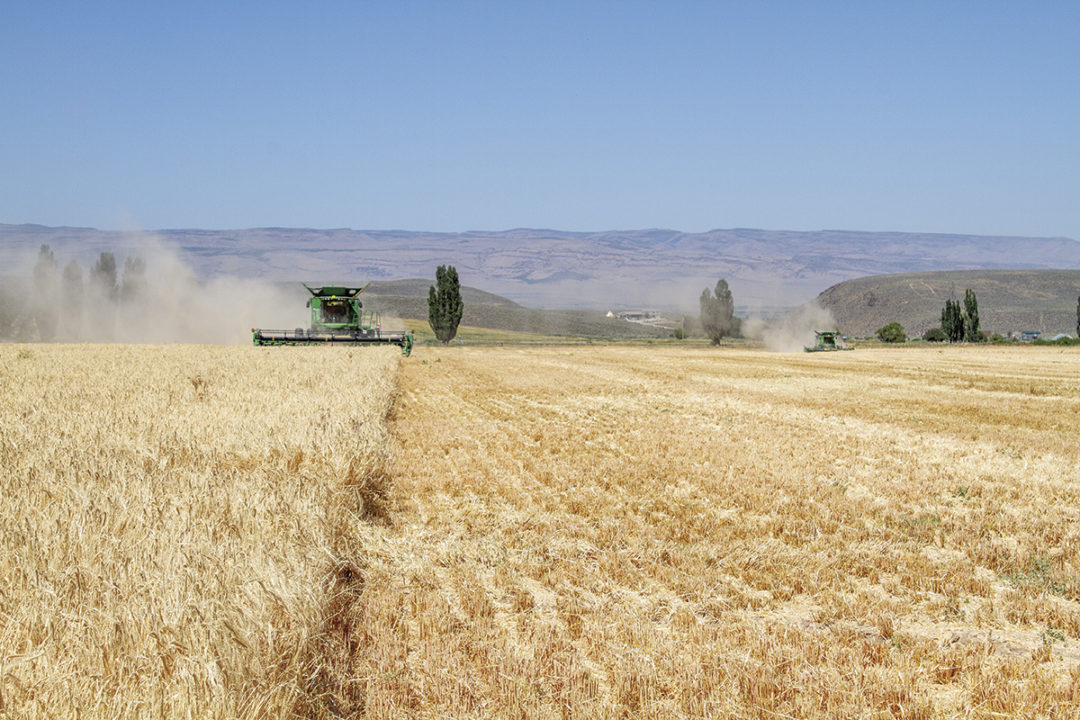Weather conditions are the number one factor influencing agriculture production. Nebraska – and much of U.S. cattle country – can face a wide variety of harsh environments, from bitter cold to extreme heat, from floods to severe droughts. These weather conditions can leave ranchers with limited feed options for their cattle but at the same time also provide opportunity to access low-quality feeds at decreased costs.
Grain source
The U.S. produced 1.65 billion bushels of wheat in 2020, with wheat ranking as the third-largest produced grain after corn and soybeans. As grain prices increase, dependent on availability, utilizing wheat may be an option for cattle producers to implement in their feeding program. Wheat can be used to replace a portion of the grain used in diets. Compared to corn, starch in wheat is fermented more rapidly and if not fed with diligent management, can lead to digestive disorders such as bloat and acidosis, poor performance and decreased feedlot profitability. Wheat needs to be slowly introduced into a ration with a step-up program to mitigate the risk of digestive disorders. When feeding wheat, it is recommended to limit wheat to 50% of the grain portion in a finishing diet. However, with proper management and experience, diets containing greater proportions may be fed.
Wheat varieties most commonly grown in Nebraska are hard red winter wheat and hard white winter wheat, which typically have protein concentrations ranging from 10% to 14%; dry rolled corn contains from 7.5% to 9% crude protein. While wheat is slightly lower in energy than corn, wheat is lower in fiber and similar in fat content. Corn prices are commonly lower than wheat; however, there is potential for discounted, low-test-weight wheat, which may be beneficial for an operation to implement into its feeding program. Low-quality wheat may be an outcome of poor growing conditions or sprouted grains causing low test weight.
Wheat processing
Cereal grains are generally the primary source of energy in feedlot diets. The purpose of grain processing is to reduce particle size to increase availability of dietary energy. Depending on moisture content and particle size, processing grain also improves palatability while increasing rate of digestion. When feeding wheat, the kernel must be cracked or broken; however, overprocessing wheat will generate fines that will increase the rate of starch digestion, leading to potential digestive upset. Thus, it is recommended that wheat be dry rolled rather than hammer milled to prevent excess production of fines.
Roughage and distiller inclusion
Roughage inclusion is an important component in finishing diets, as it can offset the risk of acidosis in feedlot cattle. A typical finishing feedlot diet contains 5% to 15% roughage on a dry matter basis. To maintain energy intake, cattle may consume more feed when a high-concentrate diet is diluted by roughage. As roughage increases in the diet, production of saliva is increased, carrying buffers to the rumen and increasing ruminal pH.
Grain co-products from both dry and wet milling processes have become a popular, starch-free addition to feedlot finishing rations that results in greater concentrations of dietary fiber, protein and fat. Grain co-products are most commonly fed at 10% to 20%. Studies show that wet distillers grains have more energy than corn, relative to feed value. Research suggests a reduced need for additional dietary roughage when ethanol co-products are included in finishing diets, as they can replace a portion of the high-concentrate grains.
Digestive disturbances
Digestive disorders are one of the greatest concerns that feedlot operators face when feeding cattle a highly fermentable diet. High-grain diets are used to achieve maximum productivity, but more diligent management is necessary to prevent digestive disorders. Digestive disorders may arise any time during the feeding program, but they are of particular concern during adaptation to high-grain finishing diets. Not only do digestive disorders affect the health of cattle, but they also decrease rate of gain, increase cost of gain and reduce income within an operation.
Negative connotations exist regarding utilizing wheat as an energy source in feedlot cattle diets, primarily due to the increased risk of acidosis and bloat. Improper feeding of wheat can decrease rumen motility, leading to a decrease in feed intake and reducing performance. Offsetting the risk of digestive disorders in feedlot cattle fed high-grain finishing diets may be accomplished by including additional roughage, which permits moderation of starch fermentation in the rumen and accumulation of volatile fatty acids.
Diseased wheat
Vomitoxin is one of the most common mycotoxins that contaminates wheat. Cold, humid environments can lead to the production of vomitoxin (deoxynivalenol) in wheat. Vomitoxin can affect immunity in livestock and potentially decrease livestock production. The FDA limits vomitoxin fed at 10 parts per million on an 88% dry matter basis.
Ergot is also a common fungus-caused disease that can be found in wheat. Ergot intake should be less than 0.1% of the total diet. Ergot can lead to vasoconstriction, potentially causing loss of ears, tail and hooves, as well as increased breathing rates, increased temperature, excessive salivation and an overall decrease in performance.
Understanding the limitations of feeding wheat and being able to properly manage ruminal adaptation and fermentation will permit accessing low-cost alternative grains, including low-quality wheat.









